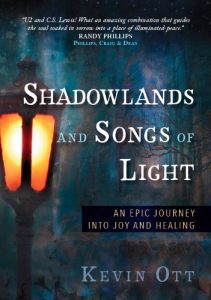 Quick note for fans of C. S. Lewis and/or U2 before the article begins:
Quick note for fans of C. S. Lewis and/or U2 before the article begins:
When life’s sorrows bring us into shadowlands, we need the joy of Christ to restore our strength. We tap into this joy by nurturing a deeper longing for God. Shadowlands and Songs of Light: An Epic Journey into Joy and Healing takes you on a quest for joy and a life-changing longing for God.
Written by a C. S. Lewis expert and a skilled composer, the book explores 18 beloved C. S. Lewis classics, from Narnia to Mere Christianity, and 13 spiritual principles behind the art of songwriting, as seen in 13 studio albums by U2–all to answer one question: how do we experience deeper joy in our relationship with Christ during times of sorrow and trial?
Shadowlands is available to pre-order at Amazon or ChristianBooks.com. If you pre-order a copy, the author will personally email you with a thank-you note and a copy of his upcoming e-book devotional “Devotions with Tolkien,” which uses J. R. R. Tolkien’s epic “The Lord of the Rings” and Scripture. (This is all on the honor system: simply pre-order Shadowlands, and then send an email to shadowlands2016 (at) gmail (dot) com letting the author (Kevin Ott) know you’ve ordered it, and he will contact you.)
Text LIGHT to 54900 to get a preview of Shadowlands and Songs of Light.
***
 [Parent’s Content Advisory at bottom of review.]
[Parent’s Content Advisory at bottom of review.]
“‘There is none like to me!”‘ says the Cub in the pride of his earliest kill;
But the Jungle is large and the Cub he is small. Let him think and be still.”
This quote comes from Rudyard Kipling’s classic book The Jungle Book, published in 1894. It is one of the “maxims of Baloo.”
Kipling’s landmark novel has inspired many adaptations, and the latest one–Disney’s live-action rendition of its animated feature
–is certainly one of Disney’s best works to date.
And it also has edifying gems of truth in it. The director Jon Favreau (Elf, Iron Man
, Chef
) oversaw a creative effort that brought more of Rudyard Kipling to the surface than the old animated version.
And, considering where we are in society, the more of Kipling the better. The emphasis on Kipling certainly serves this film well. In fact, it might be one of the best family movies Disney has made in decades. More on all of that in a moment. But first…
Entertainment Value and Film Craft
I still remember when critics and fans alike gasped in utter delight and awe in 2005 when they beheld the animated CG lion character Aslan in Chronicles of Narnia: The Lion, the Witch, and the Wardrobe. We couldn’t believe how perfect and lifelike they had made Aslan, the talking lion.
Well, 11 years later, CG technology is on a whole new level. The Jungle Book has dozens of Aslans, so to speak–CG creature after CG creature animated to perfection. And let’s not forget the jungle itself–so beautifully animated that you get the sense that the director and the animators went back to Kipling’s novel and read passages like this:
As the moon came up behind the hill it shone through the openwork, casting shadows on the ground like black-velvet embroidery.
That’s the kind of sentence in literature that you can relish and savor like a good meal. The sensory paintbrush of Kipling’s writing was potent, and this live-action film tries to match that potency with its incredible feat of visual art.
Themes of Redemption in the Story, Worldview (and How You Can Use This Film for Stimulating Spiritual Conversation in Your Small Groups or Sermons)
Content advisory for this film…
Rated: PG
Sexual Content/Nudity/Themes of Sexuality: None.
Violence/Gore/Scary Content: This is why it’s rated PG. The film revolves around a plot in which an evil man-eating tiger is hunting a boy. The tiger kills animals too for no reason. The boy encounters other predators who try to eat him or crush him, and many of these creatures are portrayed with frightening intensity as they growl and roar and lunge with their teeth, claws, fangs, and fists. This jungle is likely too intense for younger kids. There is no gore, however. Any violent wounds or deaths (which do happen) occur off-camera. But the intensity and realism of these jungle beasts would likely give very young ones some serious nightmares. If your child isn’t quite old enough to graduate from G movies or is on the border between G and PG movies, this might not be a good choice as their first PG movie. It’s an intense PG.
Language: None.
Alcohol/Drug/Smoking Content: None.



This movie is extremely New Age. Elephants are named as the creators of all the animals except for man. They are even bowed to. Keep this out of a Christian home it defies the very core of the Genesis creation account.